I started using Qt5 a little while ago and I don't know how to set the position of my drawing in my window.
I have a Drawing class which is a QWidget and which contains my paintEvent() function and other functions; and a MainWindow class which contains some widgets. So in order to display my Qpainter, I have to include it in my layout, which is the main window layout, but the window doesn't adapt to the Qpainter at all; the dimensions of the buttons, sliders .. adapt so as to organize themselves and occupy all the space of my window, but they totally ignore my Qpainter and it partly disappears if I put at least 2 widgets.
Do you have any solutions to better manage the position of these elements?
main.cpp :
#include <QtGui>
#include <QApplication>
#include "mywidget.h"
int main( int argc, char **argv )
{
QApplication app(argc, argv);
MainWindow window;
window.show();
return app.exec();
}
mywidget.h :
#ifndef MYWIDGET_H
#define MYWIDGET_H
#include <QtGui>
#include <QWidget>
#include <QSlider>
#include <QScrollBar>
#include <QApplication>
#include <QGridLayout>
#include <QObject>
#include <QPoint>
#include <QLabel>
#include <QPolygon>
class Drawing : public QWidget
{
Q_OBJECT
public:
Drawing();
void paintEvent(QPaintEvent* e);
public slots:
void slide(int abscisse);
void rotate();
private:
QPoint o;
QPoint a;
QPoint b;
QPoint c;
QPoint d;
};
//--------------------------------------
class MainWindow : public QWidget
{
Q_OBJECT
public:
MainWindow();
private:
QSlider* m_slider1;
QSlider* m_slider2;
QGridLayout* m_layout;
Drawing* m_dessin;
};
#endif // MYWIDGET_H
mywidget.cpp :
#include "mywidget.h"
#include <iostream> //POUR LES TESTS
MainWindow::MainWindow() : QWidget()
{
setGeometry(330, 140, 840, 620);
m_slider1 = new QSlider(Qt::Horizontal, this);
m_slider1->setRange(150, 650);
m_slider1->setSliderPosition(400);
m_slider2 = new QSlider(Qt::Horizontal, this);
m_slider2->setSliderPosition(50);
m_layout = new QGridLayout;
m_layout->addWidget(new QLabel("Translation Horizontale"), 1, 0);
m_layout->addWidget(m_slider1, 2, 0);
m_layout->addWidget(new QLabel("Rotation"), 0, 1);
m_layout->addWidget(m_slider2, 1, 1);
m_dessin = new Drawing;
m_layout->addWidget(m_dessin, 0, 0);
setLayout(m_layout);
QObject::connect(m_slider1, SIGNAL(valueChanged(int)), m_dessin, SLOT(slide(int)));
QObject::connect(m_slider2, SIGNAL(valueChanged(int)), m_dessin, SLOT(rotate()));
}
//--------------------------------------------------------
Drawing::Drawing() : QWidget(), o(400, 150), a(o.x()-50 , o.y()-50), b(o.x()+50 , o.y()-50), c(o.x()+50 , o.y()+50), d(o.x()-50 , o.y()+50) {}
void Drawing::paintEvent(QPaintEvent *e) {
QPolygon poly;
poly << a << b << c << d;
QWidget::paintEvent(e); // effectue le comportement standard
QPainter painter(this); // construire
painter.setPen( QPen(Qt::white, 2) ); // personnaliser
painter.drawPolygon(poly); // dessiner
}
void Drawing::slide(int abscisse) {
if (a == QPoint(o.x()-50 , o.y()-50)) {
o.setX(abscisse);
a.setX(o.x()-50);
b.setX(o.x()+50);
c.setX(o.x()+50);
d.setX(o.x()-50);
}
else {
o.setX(abscisse);
a.setX(o.x());
b.setX(o.x()+75);
c.setX(o.x());
d.setX(o.x()-75);
}
update();
}
void Drawing::rotate() {
if (a == QPoint(o.x()-50 , o.y()-50)) {
a = QPoint(o.x() , o.y()+75);
b = QPoint(o.x()+75 , o.y());
c = QPoint(o.x() , o.y()-75);
d = QPoint(o.x()-75 , o.y());
}
else {
a = QPoint(o.x()-50 , o.y()-50);
b = QPoint(o.x()+50 , o.y()-50);
c = QPoint(o.x()+50 , o.y()+50);
d = QPoint(o.x()-50 , o.y()+50);
}
update();
}
Snapshots:







